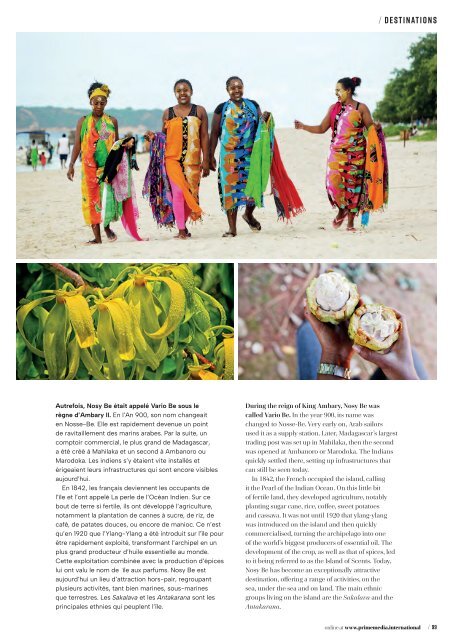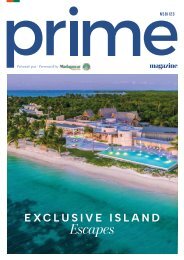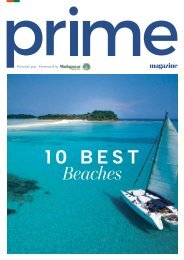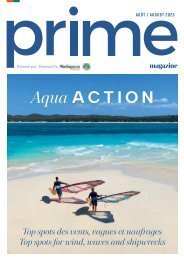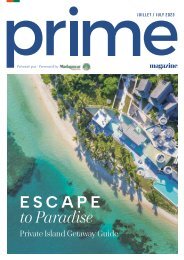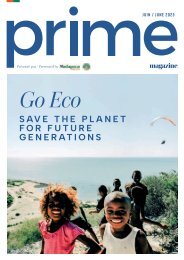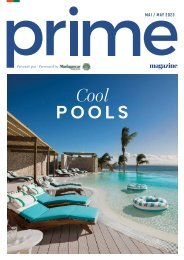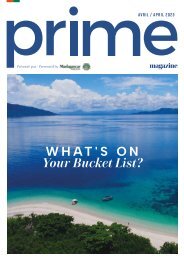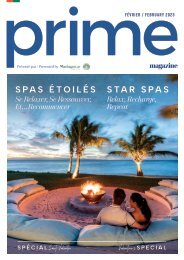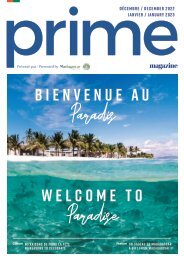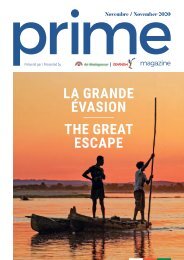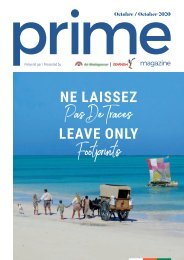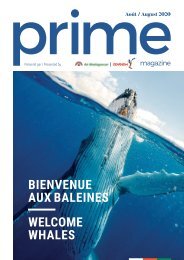Prime Magazine Mars / March 2023
Create successful ePaper yourself
Turn your PDF publications into a flip-book with our unique Google optimized e-Paper software.
DESTINATIONS<br />
Autrefois, Nosy Be était appelé Vario Be sous le<br />
règne d’Ambary II. En l’An 900, son nom changeait<br />
en Nosse-Be. Elle est rapidement devenue un point<br />
de ravitaillement des marins arabes. Par la suite, un<br />
comptoir commercial, le plus grand de Madagascar,<br />
a été créé à Mahilaka et un second à Ambanoro ou<br />
Marodoka. Les indiens s’y étaient vite installés et<br />
érigeaient leurs infrastructures qui sont encore visibles<br />
aujourd’hui.<br />
En 1842, les français deviennent les occupants de<br />
l’île et l’ont appelé La perle de l’Océan Indien. Sur ce<br />
bout de terre si fertile, ils ont développé l’agriculture,<br />
notamment la plantation de cannes à sucre, de riz, de<br />
café, de patates douces, ou encore de manioc. Ce n’est<br />
qu’en 1920 que l’Ylang-Ylang a été introduit sur l’île pour<br />
être rapidement exploité, transformant l’archipel en un<br />
plus grand producteur d’huile essentielle au monde.<br />
Cette exploitation combinée avec la production d’épices<br />
lui ont valu le nom de île aux parfums. Nosy Be est<br />
aujourd’hui un lieu d’attraction hors-pair, regroupant<br />
plusieurs activités, tant bien marines, sous-marines<br />
que terrestres. Les Sakalava et les Antakarana sont les<br />
principales ethnies qui peuplent l’île.<br />
During the reign of King Ambary, Nosy Be was<br />
called Vario Be. In the year 900, its name was<br />
changed to Nosse-Be. Very early on, Arab sailors<br />
used it as a supply station. Later, Madagascar’s largest<br />
trading post was set up in Mahilaka, then the second<br />
was opened at Ambanoro or Marodoka. The Indians<br />
quickly settled there, setting up infrastructures that<br />
can still be seen today.<br />
In 1842, the French occupied the island, calling<br />
it the Pearl of the Indian Ocean. On this little bit<br />
of fertile land, they developed agriculture, notably<br />
planting sugar cane, rice, coffee, sweet potatoes<br />
and cassava. It was not until 1920 that ylang-ylang<br />
was introduced on the island and then quickly<br />
commercialised, turning the archipelago into one<br />
of the world’s biggest producers of essential oil. The<br />
development of the crop, as well as that of spices, led<br />
to it being referred to as the Island of Scents. Today,<br />
Nosy Be has become an exceptionally attractive<br />
destination, offering a range of activities, on the<br />
sea, under the sea and on land. The main ethnic<br />
groups living on the island are the Sakalava and the<br />
Antakarana.<br />
online at www.primemedia.international / 99


